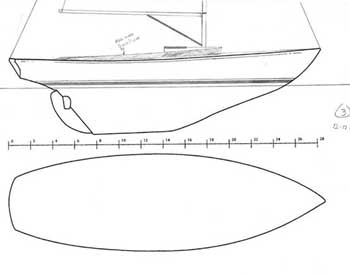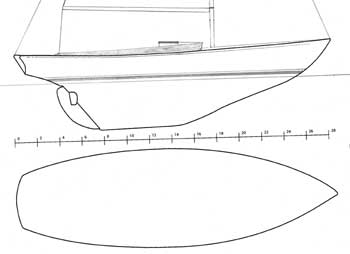
|
|
~MENU~ |
| Home |
| The Concept |
| The Boat |
| Bringing Her Home |
|
Weekly Progress Log |
|
Daysailor Projects |
| The Boat Barn |
| Resources |
| Other Sites |
| Email Tim |
|
|
| The Concept Part 3 | ||
|
The Final Concept (more or less) The first two concepts and discussion of their relative merits (or lack thereof) led me down the road to this third, and essentially final, design--subject to ultimate refinement and minor changes. In this design, I came up with a melding of the puritan open-cockpit daysailor--a classic style--and the slightly more modern fixed coachroof design I originally was playing with. Certainly the concept I arrived at is not entirely new, and I relied heavily upon the basic styling and design of some existing boats, new and old. Still, it was a joyful moment to put this idea on paper, on top of the blank Triton hull profile, and the design came to life. Something in the crude drawing just looked right, and I began to visualize exactly how the finished boat would look ghosting through the water.
|
Inspirations
Apparently I'm a Joel White fan, since all three of the above boats were designed by him.
|
|
|
My own thoughts on this concept are that the Triton hull, which looks completely different without the original deck configuration is an excellent foil for a basic unadorned cuddy design as shown above. The drawing doesn't show any details on the deck plan, but the idea is that the cockpit coamings would essentially sweep around and become the low cabin trunk at the forward end of the cockpit, and form a smooth curve around forward of the mast (rather than come to a point as shown in the three "inspirations" to the right). Click here for more information on the "design" process. At the forward end, a crowned coachroof would curve down to the coamings, forming a basic cuddy cabin. There will be an aft bulkhead to enclose this small, basic (yet well-finished) cabin, which will mainly be used for storage. A small diesel engine will be installed beneath the cockpit sole, and other systems will be minimal in keeping with the spirit of the boat. This will not be a boat that doubles as a cruiser (though I suppose die-hards could weekend aboard), and no such amenities will be included. The design will retain the standard Triton hull, though with a new rudder, and the rigging and sail plan will remain as originally designed with no substantive changes, though the spar and all rigging will be new. The goal is not to change or "improve" upon the original sailing ability of the Triton; instead, the only goal is to create a new deck upon which to sit and sail this great design. Although I was happy with my more-or-less final Concept 3, some new photos of older wooden boats in a recent copy of Wooden Boat magazine inspired me to revisit the general idea I had with Concept 2: a small cabin house entirely aft of the mast, leaving a sleek, clean foredeck and giving a low-slung appearance. Upon further reflection, I decided to try a fourth concept, basically the same as Concept 3 above, but with the small cabin house moved aft so that it is entirely behind the mast.
This is a very rough sketch, and I'm not sure I like it better at all, but it was something I wanted to try. I think the design of Concept 3 might somehow be a bit sleeker, drawing out the lines of the hull better. The shorter cabin trunk and cockpit of Concept 4 seems to make the boat appear stubbier. It might just be the execution of the drawing, but I'm not convinced. Still, the point of these concepts is more to reject certain things than it is about actually finding the perfect design. The more ideas I reject, the more clear the final execution becomes. When I first posted this new concept the first week of January 2003, I requested input from visitors to the site, as well as other people. Most responses came back in favor of the general look of Concept 3, though there were positive comments about Concept 4 as well. Given that I personally liked Concept 3 the best, and that public opinion seemed to also favor that general idea, I decided to press forward with finalizing that concept. To those of you who offered, and continue to offer, your thoughts, opinions and encouragement--thanks! Isn't that a big daysailor? This is a common question I've been receiving from some people to whom I've mentioned the concept. My own feeling is that no, this is not too large a boat for a daysailor. Should day boats be much larger? Well,. I suppose that depends on the individual, but 28 feet, when it is as compactly designed as the Triton, seems to be an excellent size for a fine day boat. After all, many, many people own much more complicated--and larger--sailboats with full accommodations and the like that are used only for day sails, with no overnight stays. Frankly, most Tritons are used more for this purpose than for cruising these days--the overall feeling amongst the boating public is that one needs a larger boat for effective cruising. (Though this is hardly germane to the topic, I happen to disagree with this trend. Why have more when less is often better? That's why I enjoy sailing and cruising my own Triton, Glissando.) Will this concept appeal to everyone? Of course not. Few things do. Really, the concept only has to appeal (firstly) to me, as the creator, and (secondly) to one realistic and excited buyer--eventually. To see the concept become more concrete, and the design and construction planning process, please click below. |
||




